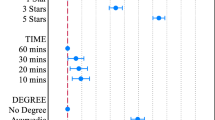Abstract
This paper tests adverse selection in the market for child care. A unique data set containing quality measures of various characteristics of child care provided by 746 rooms in 400 centers, as well as the evaluation of the same attributes by 3,490 affiliated consumers (parents) in the U.S., is employed. Comparisons of consumer evaluations of quality to actual quality show that after adjusting for scale effects, parents are weakly rational. The hypothesis of strong rationality is rejected, indicating that parents do not utilize all available information in forming their assessment of quality. The results demonstrate the existence of information asymmetry and adverse selection in the market, which provide an explanation for low average quality in the U.S. child care market.





Similar content being viewed by others
Notes
Bond (1982) investigated whether or not there was a difference between the maintenance records of pickup trucks that were purchased and used and those that were original-owner trucks. To the extent that maintenance records are proxies of quality, this paper is an exception.
See Blau (2001), Chapter 2 for a detailed overview of the child care market.
See Poterba (1995) for a detailed discussion of the reasons for government intervention in health care and education markets.
Most of the data collectors were individuals who were involved in early childhood education, such as former child care teachers, assistant teachers, or center directors. After a week-long training program, data collectors were required to carry out actual observations and data collection in actual centers. During these practices, inter-rater reliability was evaluated, and site coordinators, who were individuals with experience in administering the survey instruments, provided additional training if the agreement between observers was less than 80%. It should be noted that this is the standard procedure to train data collectors in child development research, and this study arguably provided some of the best training to the data collectors in terms of the duration of the training, emphasis on inter-rater reliability, and providing in-person training (as opposed to training through videos, etc.).
There were no statistically significant differences between centers that participated in the study and centers that declined to participate with respect to such characteristics as the legal capacity of the center, age of the center, auspice type, enrollment, and the age group of children served. Similarly, no systematic state and auspice differences are found in the return rates for parent surveys. Details can be found in Mocan (1997) and Cryer and Burchinal (1997).
Line B is discussed below.
Easy-to-observe aspects for infant-toddler include the following: furniture for routine care; furniture for play and learning; softness in room; room arrangement; arriving and leaving times; keeping children clean and neat; talking with children; small muscle activities; active play activities; chances for children to make friends; teacher’s behavior with children; discipline; and daily schedule. Difficult-to-observe aspects for infant-toddlers include: room decoration; meals and snacks; nap time; diapering and toileting; healthful caring; health rules; safe caring; safety rules; books and pictures activities; art activities for toddlers; music activities; activities with blocks; pretend play; sand and water play; and activities for different cultures. Preschool observable quality includes: arriving and leaving; diapering and toileting; keeping children clean; furniture for routine care; furniture for play and learning; furnishing for relaxation and comfort; room arrangement; room decoration; small muscle activities; space for active play; how teacher supervises active play; pretend play; schedule; how teacher supervises play activities; free-choice play activities; and how pleasant the room feels. Preschool unobservable quality includes: meals and snacks; nap or rest time; helping children to understand talk; helping children learn to talk well; helping children learn to think and reason; teacher’s talking; supervision of small muscle activities; equipment for active play; time for active play; art activities; music activities; block play; sand and water play; space for child to be alone; group times; and activities about different cultures.
The first-stage regressions had explanatory power. The mean R square of all models was 0.29.
When Eq. 1 is estimated by OLS, the estimated coefficients of Q were smaller than the ones obtained from instrumental variables estimation, and the hypothesis of weak rationality was rejected in each case. All of these results are available upon request.
For example, consider the question on napping, which includes aspects of the nap schedule, adult supervision, and the quality of the nap area. Imagine that the accurate rating of this question is a 5 on the scale from 1 to 7, and parents who have the opportunity to observe the center repeatedly give this question a rating of 5 on average. Imagine further, that when the trained observers visited the center, it was a “bad” day for whatever reason, and the center received a rating of 4.
Robust standard errors are adjusted for clustering at the center level.
In the light of the results of the previous section, this formulation conjectures that parents may overestimate by 3, 2, or 1 points. For example, if parents overestimate by 3 points, then, an average parent is going to assign a rating of 7 when actual quality is equal to 4. In this case, when actual quality is 5, the parent is forced to assign 7, despite the fact that she is willing to assign 8. In this example, censoring exists when actual quality is 4 or greater.
The percentage of negative prediction errors was 20 in total quality, 16 in observable quality, and 24 in unobservable quality.
The amount of information parents extract from centers and classrooms may depend on their children’s tenure at the center. However, the data set does not contain information on time spent at the center to analyze this aspect.
References
Akerlof GA (1970) The market for ‘Lemons’: quality uncertainty and the market mechanism. Q J Econ 84(3):488–500
Beckman SR (1992) The sources of forecast errors: experimental evidence. J Econ Behav Organ 19:237–244
Bergmann BR (1996) Saving our children from poverty: what the United States can learn from France. Russell Sage Foundation, New York
Blau DM (1991) The economics of child care. Russell Sage Foundation, New York
Blau DM (1997) The production of quality in child care centers. J Hum Resour 32(2):354–387
Blau DM (2001) The child care problem: an economic analysis. Russell Sage Foundation, New York
Blau DM, Mocan HN (2002) The supply of quality in child care centers. Rev Econ Stat 84(3):483–496
Bond EW (1982) A direct test of the “Lemons” model: the market for used pickup trucks. Am Econ Rev 72(4):836–840
Buzzell RD, Nourse REM, Mathews JB, Levitt T (1972) Marketing: a contemporary analysis. McGraw-Hill, New York
Chezum B, Wimmer B (1997) Roses or lemons: adverse selection in the market for thoroughbred yearlings. Rev Econ Stat 79(3):521–526
Cooper R, Ross TW (1984) Prices, product qualities and asymmetric information: the competitive case. Rev Econ Stud 51(2):197–207
Cryer D, Burchinal M (1997) Parents as child care consumers. Early Child Res Q 12(1):35–58
Feenberg DR, Gentry W, Gilroy D, Rosen HS (1989) Testing the rationality of state revenue forecasts. Rev Econ Stat 42:429–440
Genesove D (1993) Adverse selection in the wholesale used car market. J Polit Econ 101(4):644–665
Gerstner E (1985) Do higher prices signal higher quality? J Mark Res 22(2):209–215
Greenwald BC, Glasspiegel RR (1983) Adverse selection in the market for slaves: New Orleans, 1830–1860. Q J Econ 98(3):479–499
Harms T, Clifford R (1980) Early childhood environment rating scale. Teachers College, New York
Harms T, Cryer D, Clifford R (1990) Infant/toddler environment rating scale. Teachers College, New York
Hayes CD, Palmer JL, Zaslow ML (eds) (1990) Who cares for America’s children? Child care policy for the 1990s. National Academy, Washington, DC
Heinkel R (1981) Uncertain product quality: the market for lemons with an imperfect testing technology. Bell J Econ 12(2):625–636
Keane MP, Runkle DE (1998) Are financial analysts’ forecasts of corporate profits rational? J Polit Econ 106(4):768–805
Lamb ME (1998) Nonparental child care: context, quality, correlates, and consequences. In: Sigel I, Renninger K (eds) Damon W (series ed) Child psychology in practice. Handbook of child psychology, 5th edn. Wiley, New York
Lazar I, Darlington R (1982) Lasting effects of early education: a report from the consortium for longitudinal studies. The University of Chicago Press, Chicago
Leland HE (1979) Quacks, lemons and licensing: a theory of minimum quality standards. J Polit Econ 87(6):1328–1346
Love JM, Schochet PZ, Meckstroth AL (1996) Are they in any real danger? what research does- and doesn’t-tell us about child care quality and children’s well-being. Manuscript: Mathematica Policy Research, Princeton, New Jersey
Milgrom P, Roberts J (1986) Price and advertising signals of product quality. J Polit Econ 94(4):796–821
Mocan HN (1995) Quality adjusted cost functions for child care centers. Am Econ Rev 85(2):409–413
Mocan HN (1997) Cost functions, efficiency, and quality in day care centers. J Hum Resour 32(4):861–891
Mocan HN (2000) Information asymmetry in the market for child care. Final Report, Smith Richardson Foundation
Mocan HN, Azad S (1995) Accuracy and rationality of state general fund revenue forecasts: evidence from panel data. Int J Forecast 11:417–427
Mocan HN, Burchinal M, Morris JR, Helburn SW (1995) Models of quality in center child care. In: Helburn SW (ed) Cost, quality, and child outcomes in child care centers, technical report. Department of Economics, Center for Research in Economic and Social Policy, University of Colorado at Denver, Denver, Colorado
Monroe KB (1973) Buyers’ subjective perceptions of price. In: Kassarjian HH, Robertson TS (eds) Perspectives in consumer behavior. Scott Foresman, Glenview, Illinois, pp 23–42
Mullineaux DJ (1978) On testing for rationality: another look at the Livingston price expectations data. J Polit Econ 86:329–336
Poterba J (1995) Government intervention in markets for education and health: how and why. In: Fuchs (ed) Individual and social responsibility. Chicago, University of Chicago, Illinois, pp 277–304
Ramey C, Campbell F (1991) Poverty, early childhood education and academic competence: the Abecedarian experiment. In: Houston (ed) Children and poverty: child development and public policy. Cambridge University Press, New York, pp 190–221
Rosenman RE, Wilson WW (1991) Quality differentials and prices: are cherries lemons? J Ind Econ 39(6):649–658
Shapiro C (1982) Consumer information, product quality and seller reputation. Bell J Econ 13:20–35
Shapiro C (1986) Investment, moral hazard, and occupational licensing. Rev Econ Stud 53(5):843–862
Smith K (2002) Who’s minding the kids? Child care arrangements: spring 1997 Current Population Report 1970–1986. U.S. Census Bureau, Washington, DC
U.S. Bureau of the Census (2004) American community survey. Washington DC
von Ungern-Sternberg T, von Weizsacker CC (1985) The supply of quality on a market for “Experienced Goods”. J Ind Econ 33(4):531–540
Waldfogel J (2002) Child care, women’s employment and child outcomes. J Popul Econ 15:527–548
Weisbrod BA (1988) The nonprofit economy. Harvard University Press, Cambridge, Massachusetts
Whitebook M, Howes C, Phillips D (1990) Who cares? Child care teachers and the quality of care in America. Final report of the National Child Care Staffing Study. Child Care Employee Project, Oakland, California
Wolinsky A (1983) Prices as signals of product quality. Rev Econ Stud 50(4):647–658
Acknowledgements
This research is supported by a grant from the Smith Richardson Foundation to the NBER (Grant No: 9901-651) and also by an NBER Nonprofit Sector Research Grant. Paul Niemann, Kaj Gittings, and Damba Lkhagvasuren provided outstanding research assistance. I thank Jeffrey Zax, Patrick Emerson, Murat Iyigun and two referees for helpful comments.
Author information
Authors and Affiliations
Corresponding author
Additional information
Responsible editor: Deborah Cobb-Clark
Appendix
Appendix
Rights and permissions
About this article
Cite this article
Mocan, N. Can consumers detect lemons? An empirical analysis of information asymmetry in the market for child care. J Popul Econ 20, 743–780 (2007). https://doi.org/10.1007/s00148-006-0087-6
Received:
Accepted:
Published:
Issue Date:
DOI: https://doi.org/10.1007/s00148-006-0087-6




